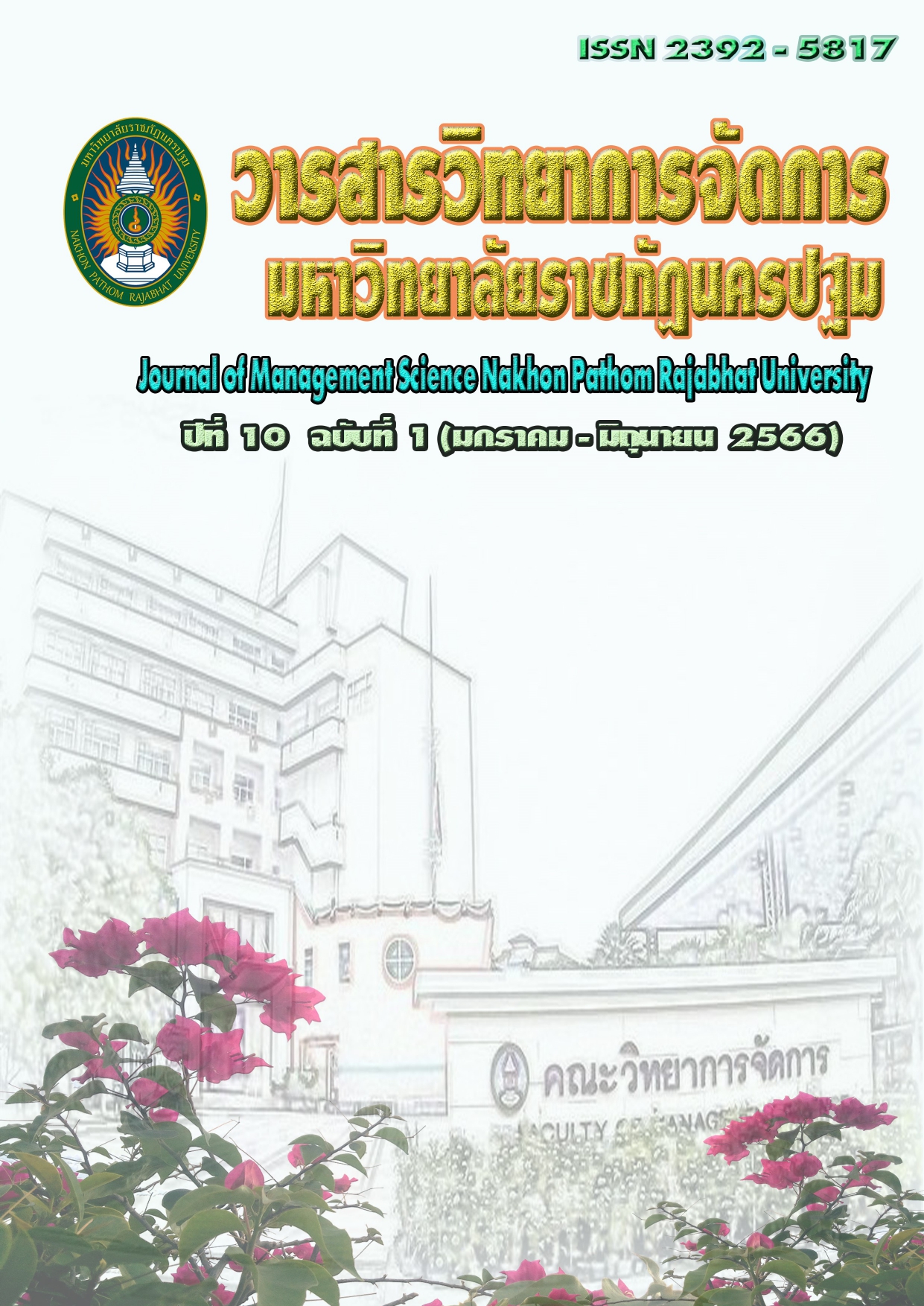Indicators for being an innovative organization in Thailand
Main Article Content
Abstract
Today's world is undergoing swift and rapid changes. Due to this fact, industries planned strategies can change, be invented, or fail at a moment's notice. This fact and the increasingly volatile competition in the global economy drove organizations to improve to survive. Innovation is, therefore, the key element that may sustainably help organizations in the face of the challenge mentioned.
Organizations must abide by indicators to lead to a guideline for a transformation into innovative ones. Indicators must establish clear directions, objectives, goals, and strategies and create innovations to elevate organizational performance. Organization leaders must be visionary and developer, turning one’s organization into a learning organization. One must also be dedicated, aiming to create organizational culture, prioritizing human resource development, and directing the organization to continuously develop human resources, business, innovations, and services.
Article history: Received 12 March 2023
Revised 2 May 2023
Accepted 3 May 2023
SIMILARITY INDEX = 2.86%...................
Article Details

This work is licensed under a Creative Commons Attribution-NonCommercial-NoDerivatives 4.0 International License.
The views and opinions of the article appearing in this journal are those of the author. It is not considered a view and responsibility of the editorial staff.
References
กีรติ ยศยิ่งยง. (2552). องค์การแห่งนวัตกรรม แนวคิด และกระบวนการ. กรุงเทพมหานคร: โรงพิมพ์แห่งจุฬาลงกรณ์มหาวิทยาลัย.
ขวัญใจ เตชเสนสกุล. (2562). VUCA World โลกแห่งความผันผวน...New Normal ในยุคปัจจุบัน. [ออนไลน์]. ค้นเมื่อ 19 กุมภาพันธ์ 2566 จาก https://www.exim.go.th/getattachment
ชัชพล ทรงสุนทรวงศ์. (2559). นวัตกรรมการบริการ : กลยุทธ์ที่สร้างความได้เปรียบทางการแข่งขันขององค์การธุรกิจบริการ. วารสารการจัดการสมัยใหม่, 14(2), 13-24.
ประเวช ชุ่มเกษรกูลกิจ, ศจีมาจ ณ วิเชียร. (2561). พฤติกรรมสร้างนวัตกรรมในการทำงานแนวคิดปัจจัยเชิงสาเหตุ ความท้าทาย, วารสารพฤติกรรมศาสตร์เพื่อการพัฒนา, สถาบันวิจัยพฤศาสตร์มหาวิทยาลัยศรีนครินทรวิโรฒ, (10), 25-41.
สำนักงานข้าราชการพลเรือน. (2566). Digital Disruption และมาตรการรับมือด้าน HR ของภาครัฐ. [ออนไลน์]. ค้นเมื่อ 19 กุมภาพันธ์ 2566 จาก https://www.ocsc.go.th/sites/default/files/digital_disruption-article-ocsc-feb2020.pdf
สนั่น เถาชารี. (2551). กลยุทธ์การบริหารความเสี่ยงด้านทรัพยากร บุคคลเพื่อความสำเร็จขององค์กร. Industrial Technology Review (187), 145-151.
สำนักงานนวัตกรรมแห่งชาติ. (2547). การจัดการนวัตกรรมสำหรับนักบริหาร. กรุงเทพมหานคร: สำนักงานนวัตกรรมแห่งชาติ กระทรวงวิทยาศาสตร์และเทคโนโลยี.
สำนักงานนวัตกรรมแห่งชาติ. (2549). สุดยอดนวัตกรรมไทย. กรุงเทพมหานคร: สำนักงานนวัตกรรมแห่งชาติ กระทรวงวิทยาศาสตร์และเทคโนโลยี.
สำนักงานนวัตกรรมแห่งชาติ. (2553). การจัดการนวัตกรรมสำหรับผู้บริหาร (พิมพ์ครั้งที่ 3). กรุงเทพมหานคร: สำนักงานนวัตกรรมแห่งชาติ กระทรวงวิทยาศาสตร์และเทคโนโลยี.
สำนักงานนวัตกรรมแห่งชาติ (องค์การมหาชน). (2564). ประเทศไทยบนเวทีดัชนีนวัตกรรมโลก Global Innovation Index (GII 2021). [ออนไลน์]. ค้นเมื่อ 14 พฤศจิกายน 2565 จาก https://regional.nia.or.th/th/content/category/detail/id/10/iid/59
สำนักงานพัฒนาธุรกรรมทางอิเล็กทรอนิกส์. (2562). ขีดความสามารถในการแข่งขันของไทยปี 2019 โดย World Economic Forum. [ออนไลน์]. ค้นเมื่อ 10 ธันวาคม 2565 จาก https://www.etda.or.th/th/Useful-Resource/knowledge-sharing/articles/Global-Competitiveness-Index.aspx
อนันต์ มณีรัตน์. (2559). ความผูกพันในองค์การ: ศึกษากรณี สำนักเลขาธิการคณะรัฐมนตรี.วิทยานิพนธ์ หลักสูตรปริญญารัฐประศาสนศาสตรมหาบัณฑิต สาขาวิชารัฐประศาสนศาสตร์ ภาควิชารัฐประศาสนศาสตร์ คณะรัฐศาสตร์ จุฬาลงกรณ์มหาวิทยาลัย.
Ekvall, G. (2002). The Climate for Creativity and Innovation. M1 Creativity Fresh Perspective Ideas Solution. Retrieved October 1, 2021 from http://www.m1creativity.co.uk/innovationclimate.html.
Jon-Arild, J. (2009). A systemic approach to innovation: The interactive Innovation model. Kybernetes, 38(1-2), 158-176.
Harvard Business School. (2003). Managing creativity and innovation. Boston: Harvard Business School.
Holder, B. J., & Matter, G. (2008). The Innovative Organization. Retrieved October 1, 2021 from http://www.geocities.com/CollegePark/Library/1048/innova.html.
McGregor, J. (2008). The World's Most Innovative Companies. Bloomberg BusinessWeek. (April). Retrieved October 1, 2021 from http://www.businessweek.com/magazine/
content/08_17/b4081061866744.html.
Sunje, A., & Pasic, M. (2003). Innovative Organization Human Resource Management Model. In 7 th International Research/Expert Conference “Trends in the Development of Machinery and Associated Technology”. pp. 1-3.
Tidd, J., Bessant, J., & Pavitt, K. (2001). Managing Innovation Integrating Technological Market and Organization Change. Chichester: John Willey & Sons.

